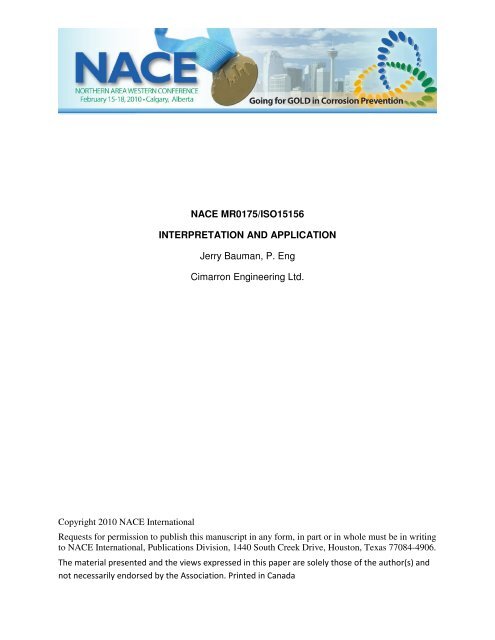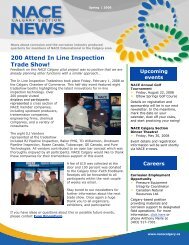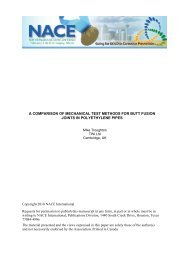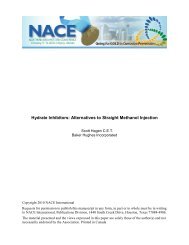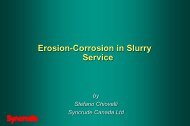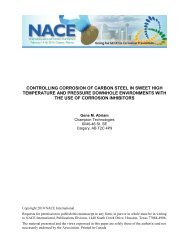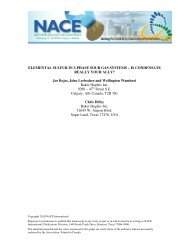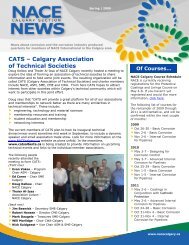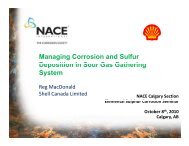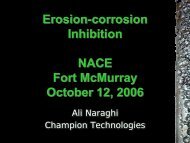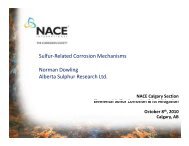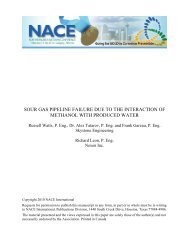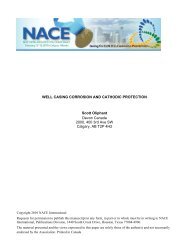NACE MR0175-ISO15156 Interpretation and ... - NACE Calgary
NACE MR0175-ISO15156 Interpretation and ... - NACE Calgary
NACE MR0175-ISO15156 Interpretation and ... - NACE Calgary
You also want an ePaper? Increase the reach of your titles
YUMPU automatically turns print PDFs into web optimized ePapers that Google loves.
<strong>NACE</strong> <strong>MR0175</strong>/<strong>ISO15156</strong><br />
INTERPRETATION AND APPLICATION<br />
Jerry Bauman, P. Eng<br />
Cimarron Engineering Ltd.<br />
Copyright 2010 <strong>NACE</strong> International<br />
Requests for permission to publish this manuscript in any form, in part or in whole must be in writing<br />
to <strong>NACE</strong> International, Publications Division, 1440 South Creek Drive, Houston, Texas 77084-4906.<br />
The material presented <strong>and</strong> the views expressed in this paper are solely those of the author(s) <strong>and</strong><br />
not necessarily endorsed by the Association. Printed in Canada
<strong>NACE</strong> <strong>MR0175</strong>/<strong>ISO15156</strong><br />
INTERPRETATION AND APPLICATION<br />
Jerry Bauman, P. Eng.<br />
<strong>NACE</strong> Corrosion Specialist<br />
Cimarron Engineering Ltd.<br />
300, 6025 – 11 Street SE<br />
<strong>Calgary</strong>, Alberta<br />
T2H 2Z2<br />
ABSTRACT<br />
In 2003, the first publication of the <strong>NACE</strong> <strong>MR0175</strong>/<strong>ISO15156</strong> (<strong>NACE</strong>/ISO) document<br />
entitled “Petroleum <strong>and</strong> Natural Gas Industries – Materials for Use in H 2 S Containing<br />
Environments in Oil <strong>and</strong> Gas Production” appeared. The document consisted of three<br />
distinct parts. This paper focuses on Part 2, entitled “Cracking-Resistant Carbon <strong>and</strong><br />
Low-Alloy Steels, <strong>and</strong> the Use of Cast Iron”, the various nuances created in this<br />
document that did not exist in its predecessor <strong>NACE</strong> <strong>MR0175</strong>, <strong>and</strong> the confusion as to<br />
how these nuances are interpreted <strong>and</strong> used in practical applications. This paper also<br />
discusses how various industry “experts”, as well as, government regulatory bodies<br />
have chosen to interpret the document with respect to new construction <strong>and</strong> changing<br />
H 2 S partial pressures within existing pipeline systems.<br />
Background<br />
<strong>NACE</strong> <strong>MR0175</strong> (<strong>NACE</strong>) was first issued in 1975 <strong>and</strong> became a worldwide reference for<br />
the use of metals in H 2 S containing environments with respect to sulphide stress<br />
corrosion cracking resistance. In 2003, it was merged into the ISO system <strong>and</strong> the new<br />
document was designated as <strong>NACE</strong> <strong>MR0175</strong>/<strong>ISO15156</strong>. There are significant<br />
differences between the two documents, some of which will be discussed subsequently.<br />
The biggest initial impact was the severe restrictions imposed regarding the use of<br />
austenitic stainless steels in sour service. While a lot of attention has been paid to this<br />
change, the impact on carbon/low alloy steels has largely been overlooked, especially in<br />
Western Canada. This paper examines some of these impacts, which are described in
Part 2 of the <strong>NACE</strong>/ISO document. The overwhelming consensus was that the new<br />
document was much more conservative than the last version of the original document.<br />
This is an important factor to bear in mind when considering some of the following.<br />
Differences between the Two Documents<br />
The definition of sour service has changed. The <strong>NACE</strong> document allowed certain<br />
exemptions, for which materials did not need to meet the requirements. Sour gas<br />
systems operating at a total pressure less than 450 kPa absolute (65 psia) were<br />
exempt, regardless of H 2 S content. In oil effluent or multi-phase systems, exemption<br />
from the st<strong>and</strong>ard was more complicated. If the total operating pressure was below<br />
1830 kPa absolute <strong>and</strong> the maximum gas:oil ratio is ≤ 5000 <strong>and</strong> the H 2 S content is ≤ 15<br />
mole percent <strong>and</strong> the H 2 S partial pressure is ≤ 70 kPa absolute (10 psia), materials<br />
were exempt. In the <strong>NACE</strong>/ISO document, “crude oil” systems operating at a total<br />
pressure ≤ 430 kPa gauge (65 psig) are exempt. The <strong>NACE</strong>/ISO document does not<br />
provide any exemption for H 2 S partial pressures below 0.3 kPa absolute (0.05 psia).<br />
In the <strong>NACE</strong> document, since its creation in 1975, one value that has not changed with<br />
respect of suitability of carbon steel in sour service is the maximum allowable hardness<br />
being 22 on the Rockwell “C” (HRC) scale, which is equivalent to 248 on the Vickers<br />
hardness scale (HV). The <strong>NACE</strong>/ISO document changed the microhardness<br />
requirement to 250 Vickers, as did Canadian St<strong>and</strong>ards Association (CSA) Z662 - 2007,<br />
however, CSA Z245.1 – 2007 still specifies 248 as the maximum allowed<br />
microhardness. While two (2) points on the hardness scale may not seem significant,<br />
when qualifying high yield strength materials weld procedures, those points may indeed<br />
mean the difference between pass or fail.<br />
The <strong>NACE</strong>/ISO document has removed the maximum yield strength limitation,<br />
recognizing that the hardness requirements are the critical property. CSA has not<br />
removed the strength restriction, the reason for which is unknown.<br />
The <strong>NACE</strong>/ISO document allows the end user to waive hardness qualification in welding<br />
procedures, providing that the specified maximum yield strength (SMYS) of the material<br />
does not exceed 360 MPa. The vast majority of pipelines are constructed from low alloy<br />
steels whose SMYS is either 290 MPa or 359 MPa. As such, the conservative<br />
<strong>NACE</strong>/ISO document implies that it is virtually impossible to exceed acceptable<br />
hardnesses in either the weld metal or the heat affected zones where the base material<br />
is relatively soft. CSA once again does not agree, as evidenced in Z-662 (2007), as<br />
well as, Z245. 1 (2007) <strong>and</strong> Z245.11/12/15 (2005), where hardness restrictions on such<br />
materials require measurement to confirm adherence to hardness specifications.
The <strong>NACE</strong>/ISO document addresses other forms of Hydrogen Embrittlement, e.g.,<br />
Hydrogen Induced Cracking, Stress Oriented Hydrogen Induced Cracking, etc., that the<br />
<strong>NACE</strong> document did not consider.<br />
The <strong>NACE</strong>/ISO document introduced the concept of field experience as an alternative<br />
for in-situ materials that were not originally intended for sour service or where the<br />
service has become more severe than the original design. A minimum period of two (2)<br />
years experience was selected as the time criteria. If the end user could demonstrate<br />
that the material has operated within a given environment for the time criteria, it became<br />
acceptable for continued service. This may sound logical <strong>and</strong> applicable, but there was<br />
an added stipulation stating that the material could not be exposed to more severe<br />
conditions than the documented experience. This is also true for autoclave testing<br />
results, which essentially shortens the exposure period from two (2) years to 500 hours.<br />
<strong>Interpretation</strong> <strong>and</strong> Application<br />
Regardless of which route is chosen, the question then becomes “How is severity<br />
defined” Figure 1 in Section 7.2.1.2 of Part 2 of the <strong>NACE</strong>/ISO document depicts four<br />
(4) regions of severity, as defined by H 2 S partial pressure <strong>and</strong> pH (See Figure 1). It is<br />
important to note that chlorides have no virtually no impact on cracking susceptibility.<br />
Nowhere in the document is there any explanation of how to use these regions. Section<br />
7.2.1.1 discusses “Option 2” which describes how to select materials for a specific<br />
service, or for a range of sour services. There following statement is at the end of the<br />
discussion: “Option 2 can also facilitate fitness-for-purpose evaluations of existing<br />
carbon or low alloy steel equipment exposed to sour service conditions more severe<br />
than assumed in the current design.” This is immediately followed by the plot of H 2 S<br />
versus pH in Figure 7.2.1.2. This infers that somehow field experience can be<br />
extrapolated, without any discussion as to how. To illustrate how these sections have<br />
led to various interpretations a specific autoclave test conditions point, which could also<br />
be a filed experience point is selected to use to justify the design/continued use of a<br />
carbon/low alloy steel in a given environment. That point selected is at an H 2 S partial<br />
pressure of 100 kPa <strong>and</strong> an in-situ pH of 2.6 (see Figure 2).<br />
One interpretation of severity, which is shared by the Energy Resources Conservation<br />
Board of Alberta (ERCB), is that the material cannot be exposed to conditions where the<br />
H 2 S partial pressure exceeds 100 kPa or the pH is less than 2.6. The shaded area in<br />
Figure 3 depicts the area of exposure that this interpretation allows. This essentially<br />
precludes using materials based on field experience. The operating conditions will<br />
define a certain H 2 S partial pressure, but the pipeline would likely have a significantly<br />
higher maximum allowable operating pressure (MAOP), which would result in a higher
H 2 S partial pressure. To illustrate, assume that the 100 kPa H 2 S partial pressure is<br />
based on a historical operating pressure of 1000 kPa with 10 mole percent H 2 S in the<br />
gas phase. If the MAOP of the pipeline is 5000 kPa, the H 2 S partial pressure could then<br />
theoretically reach 500 kPa, which falls outside of the approved area depicted on Figure<br />
3. This approach also allows a material to be used in a large area within Region 3, but<br />
will not allow the material to be used in any area of Region 2 where the H 2 S partial<br />
pressure exceeds 100 kPa. This appears contrary to the document’s definition of<br />
regions of severity, i.e., the material is suitable in Region 3, but not in certain areas of<br />
Region 2.<br />
A second interpretation of severity uses the same starting point, but instead of lines that<br />
parallel the x <strong>and</strong> y axes from that point, a line is drawn at a 45 degree angle, with the<br />
range of allowable H 2 S partial pressures <strong>and</strong> corresponding pH levels being “northwest”<br />
of this line (see Figure 4). This approach seems to be more sensible in that it<br />
recognizes that while the H 2 S partial pressure might exceed the defined point, if the pH<br />
also increases, i.e., due to lower CO 2 content, the risk of SSCC is reduced. Realistically<br />
however, it is extremely unlikely that the pH would increase, i.e., CO 2 <strong>and</strong> H 2 S mole<br />
percentages would remain constant, thus higher operating pressures would result in<br />
lower pH’s. Again, the autoclave/field experience approach becomes unusable. As<br />
with the first interpretation, a material could qualify within Region 3, but could be<br />
disqualified for use in part of Region 2.<br />
One realization in using either of the above two interpretations is that it totally negates<br />
the need for identifying regions. Instead, all that would be required is the blank graph<br />
<strong>and</strong> the ability to draw one or two straight lines through that point. Being in one region<br />
or another is irrelevant. This begs the question of why regions were created. The<br />
question was put in several different ways to ISO for clarification in July of 2009. At that<br />
point, ISO reverted that the answer would likely be forthcoming within eight (8) weeks.<br />
At the time of writing this paper, over 23 weeks have passed with no response as yet.<br />
This indicates that ISO is as confused as everyone else that has tried to use this portion<br />
of the document.<br />
CSA Z245.11/12/.15 all require that components manufactured to these three<br />
documents “shall meet Region 3” of the <strong>NACE</strong>/ISO document, with no delineation of<br />
where in the Region the qualification must meet. As previously discussed, one could<br />
easily qualify a material for Region 3, yet either or the interpretations would preclude<br />
service in numerous environments. Figures 5 <strong>and</strong> 6 show how qualifying to Region 3<br />
could leave significant areas deemed unsuitable by the previously described<br />
interpretations of severity. CSA Z245.1 requires only that the material qualify to the<br />
region where its service conditions would place it. In this case, one could perform<br />
testing at conditions that the operating conditions would never reach <strong>and</strong> thus be<br />
qualified appropriately.
It seems that the “safe” approach is to either ensure that the hardness does not exceed<br />
22 HRC/248 HV or to follow the <strong>NACE</strong>/ISO document where it states that to qualify a<br />
carbon/low alloy steel for any range of conditions, perform autoclave testing according<br />
to <strong>NACE</strong> TM0177 – 2006 (TM0177). In reality, the latest revision of TM0177 is 2005.<br />
For the sake of argument, assume that if a 2006 version had been issued, it would not<br />
have substantially changed from the 2005 version. To qualify for any environment,<br />
TM0177 specifies that “Solution A” be used, which is at an H 2 S partial pressure of 100<br />
kPa <strong>and</strong> a solution pH between 2.6 <strong>and</strong> 2.8. Note that these are the same values that<br />
were used for the previously described example. The ERCB accepts that passing this<br />
test will qualify a carbon/low alloy steel for any environment, yet, by their own<br />
interpretation, exceeding 100 kPa would not be permissible. The second interpretation<br />
previously mentioned would also preclude application at much higher H 2 S partial<br />
pressures, despite the reality that in-situ pH values within normal operating parameters<br />
rarely decrease below 4.0. As part of the earlier questions submitted to ISO for<br />
clarification, questions surrounding this aspect of material qualification were also raised.<br />
Again, to date, there has been no response to these queries.<br />
In defence of the ERCB, if ISO cannot seem to explain how to use these figures <strong>and</strong><br />
test conditions, how can the ERCB be expected to apply the document The author<br />
fully appreciates that the ERCB has a need to define an interpretation, otherwise<br />
entertaining sour conversions or increases in H 2 S partial pressures within any given<br />
pipeline could not be done.<br />
This paper would like to offer a third approach. SCC, regardless of type, behaves like a<br />
set of parameters cliff. Carbon/low alloy steel will not SSCC at any hardness below<br />
HRC 22, but could at HRC 23. These materials will not suffer SSCC at 71 0 C, but could<br />
at 69 0 C. Austenitic stainless steel are susceptible to chloride SCC at 61 0 C but not at<br />
59 0 C. Considering such cliff-like behaviour, it seems reasonable to re-look at the four<br />
regions in the <strong>NACE</strong>/ISO document as different plateaus of severity. As long as the<br />
material passes either the two-year field experience criteria or an autoclave testing<br />
criteria on any given plateau, it should be suitable for use anywhere on that plateau, or<br />
any lower plateau, i.e., a material that qualifies within Region 2, is also suitable in<br />
Regions 0 <strong>and</strong> 1. As such, as long as a material does not “fall of off the cliff”, it will not<br />
be subject to SSCC. There does not appear to be any other reason for establishing<br />
regions.<br />
Summary<br />
Part 2 of the <strong>NACE</strong>/ISO document introduced several significant changes in the manner<br />
of determining the suitability of materials for sour service. The document is some ways<br />
is much more conservative than its <strong>NACE</strong> predecessor <strong>and</strong> in some ways has removed<br />
some restrictions that previously existed. The majority of these changes are
straightforward in their intent <strong>and</strong> how they are to be applied. One area that is anything<br />
but straightforward is the definition of severity <strong>and</strong> how carbon/low alloy steels can be<br />
qualified for service should either their hardnesses be unknown or higher than HRC<br />
22/250 HV. Facing continuous applications for conversion of pipeline systems to sour<br />
service or increasing the H 2 S partial pressure within systems that already have some<br />
level of H 2 S has forced regulatory bodies to enforce their own interpretation, which has<br />
been shown to be incorrect. However, with no direction from those that wrote/approved<br />
the document, there is little other choice.
<strong>NACE</strong> <strong>MR0175</strong>/ISO 15156-2:2003<br />
Section 7.2.1.2 SSC Regions of Environmental Severity<br />
X axis – H 2 S Partial Pressure, kPa<br />
Y axis – in situ pH<br />
0 – Region 0<br />
1 – SSC Region 1<br />
2 – SSC Region 2<br />
3 – SSC Region 3<br />
Figure 1: As seen in <strong>NACE</strong> <strong>MR0175</strong>/ISO 15156
Figure 2: Single point at 100 kPa H 2 S <strong>and</strong> pH = 2.6
Figure 3: 100 kPa H 2 S <strong>and</strong> pH = 2.6, Shaded North <strong>and</strong> West
Figure 4: 100 kPa H 2 S <strong>and</strong> pH = 2.6, 45 o angle
Figure 5: 1.1 kPa H 2 S <strong>and</strong> pH = 3.5, shaded North <strong>and</strong> West
Figure 6: 1.1 kPa H 2 S <strong>and</strong> pH = 3.5, 45 o angle


